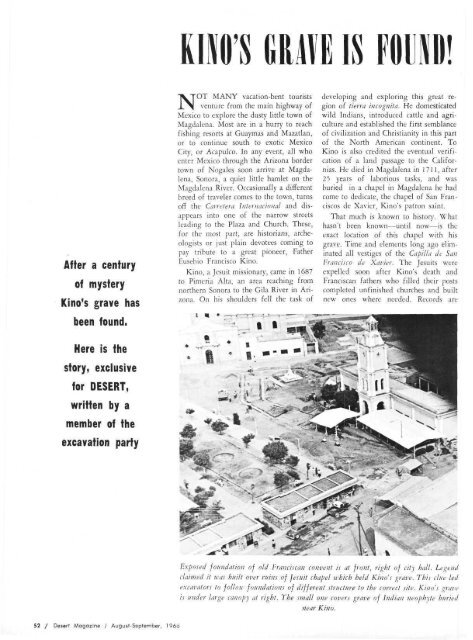AUGUST/SEPTEMBER 1 9 6 6 double issue - Desert Magazine of ...
AUGUST/SEPTEMBER 1 9 6 6 double issue - Desert Magazine of ...
AUGUST/SEPTEMBER 1 9 6 6 double issue - Desert Magazine of ...
You also want an ePaper? Increase the reach of your titles
YUMPU automatically turns print PDFs into web optimized ePapers that Google loves.
After a century<br />
<strong>of</strong> mystery<br />
Kino's grave has<br />
been found.<br />
Here is the<br />
story, exclusive<br />
for DESERT,<br />
written by a<br />
member <strong>of</strong> the<br />
excavation party<br />
52 / <strong>Desert</strong> <strong>Magazine</strong> / August-September, 1966<br />
KINO'S GRAVE IS FOUND!<br />
NOT MANY vacation-bent tourists<br />
venture from the main highway <strong>of</strong><br />
Mexico to explore the dusty little town <strong>of</strong><br />
Magdalena. Most are in a hurry to reach<br />
fishing resorts at Guaymas and Mazatlan,<br />
or to continue south to exotic Mexico<br />
City, or Acapulco. In any event, all who<br />
enter Mexico through the Arizona border<br />
town <strong>of</strong> Nogales soon arrive at Magdalena,<br />
Sonora, a quiet little hamlet on the<br />
Magdalena River. Occasionally a different<br />
breed <strong>of</strong> traveler comes to the town, turns<br />
<strong>of</strong>f the Carretera International and disappears<br />
into one <strong>of</strong> the narrow streets<br />
leading to the Plaza and Church. These,<br />
for the most part, are historians, archeologists<br />
or just plain devotees coming to<br />
pay tribute to a great pioneer, Father<br />
Faisebio Francisco Kino.<br />
Kino, a Jesuit missionary, came in 1687<br />
to Pimeria Alta, an area reaching from<br />
northern Sonora to the Gila River in Arizona.<br />
On his shoulders fell the task <strong>of</strong><br />
developing and exploring this great region<br />
<strong>of</strong> tierra incognita. He domesticated<br />
wild Indians, introduced cattle and agriculture<br />
and established the first semblance<br />
<strong>of</strong> civilization and Christianity in this part<br />
<strong>of</strong> the North American continent. To<br />
Kino is also credited the eventual verification<br />
<strong>of</strong> a land passage to the Californias.<br />
He died in Magdalena in 1711, after<br />
25 years <strong>of</strong> laborious tasks, and was<br />
buried in a chapel in Magdalena he had<br />
come to dedicate, the chapel <strong>of</strong> San Franciscos<br />
de Xavier, Kino's patron saint.<br />
That much is known to history. What<br />
hasn't been known—until now—is the<br />
exact location <strong>of</strong> this chapel with his<br />
grave. Time and elements long ago eliminated<br />
all vestiges <strong>of</strong> the Capilla de San<br />
Francisco de Xavier. The Jesuits were<br />
expelled soon after Kino's death and<br />
Franciscan fathers who filled their posts<br />
completed unfinished churches and built<br />
new ones where needed. Records are<br />
Exposed foundation <strong>of</strong> old Franciscan convent is at front, right <strong>of</strong> city hall. Legend<br />
claimed it teas built over ruins <strong>of</strong> fesuit chapel which held Kino's grave. This clue led<br />
excavators to follow foundations <strong>of</strong> different structure to the correct site. Kino's grave<br />
is under large canopy at right. The small one covers grave <strong>of</strong> Indian neophyte buried<br />
near Kino.<br />
^

















